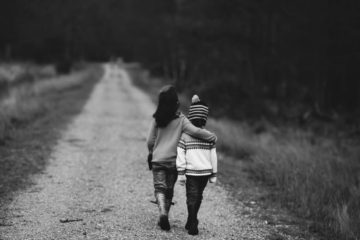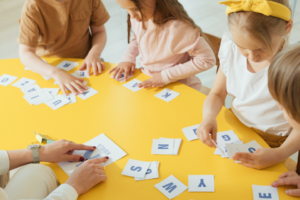
Teaching Tolerance: 3 Effective Strategies
 Tolerance, or the ability to respect and allow for others to be unique and/or different from ourselves, is an important and sometimes challenging trait and behavior. Both young and old may struggle with tolerance and it is likely best understood as an evolving personal practice and process rather than a stagnant attribute or single action. Here are three effective strategies for teaching tolerance in schools:
Tolerance, or the ability to respect and allow for others to be unique and/or different from ourselves, is an important and sometimes challenging trait and behavior. Both young and old may struggle with tolerance and it is likely best understood as an evolving personal practice and process rather than a stagnant attribute or single action. Here are three effective strategies for teaching tolerance in schools:
Identity Exploration
The first strategy is the use of an educational activity developed by a group that is called, Teaching Tolerance, which is run by the Southern Poverty Law Center. Teaching Tolerance “is dedicated to reducing prejudice, improving intergroup relations, and supporting equitable school experiences for our nation’s children,” and they have created numerous Oscar and Emmy-winning teaching materials. They offer free curricular kits and publish a magazine on the theme of tolerance. In their activity called, “Discovering My Identity,” students describe their various group identities, analyze how identities are represented in books they read as a class, and create a book review evaluating the similarities and differences between a book character’s identity and their own.
This lesson incorporates important vocabulary such as culture, ability, stereotype, and ethnicity and introduces students to 11-year-old activist Marley Dias, who sought to increase her school’s collection of books featuring diverse characters. This activity, which you can check out in full here, gives students a chance to express themselves and their identities verbally, to carry out small group and class-wide discussions, and to examine how literature and other media they encounter communicate characters’ identities. I think it’s a powerful activity because it teaches children that topics like culture, race, gender, and ability are okay to talk about in respectful ways and empowers them to do just that. I have found in my personal experience that incorporating music and visual art as ways to learn about and express identity are very effective extensions for this type of identity discovery lesson. Teaching Tolerance also offers a great contemporary activity regarding the value of protest that references the Standing Rock Sioux Tribe’s protest of the Dakota Access Pipeline.
Addressing Bullying
Bullying is a serious and intolerant behavior that must be addressed openly and not allowed to happen unnoticed in the shadows. Stop Bullying defines bullying as, “unwanted, aggressive behavior among school-aged children that involves a real or perceived power imbalance.” The power imbalance can be physical, social, or of another form and the aggression may be physical, verbal, or social. Addressing bullying goes hand-in-hand with teaching children to express their own identities, respect others’ identities, and behave in a tolerant manner. Stop Bullying explains that there are several effective steps that a school community can take to address bullying: “conduct assessments, engage parents and youth, create policies and rules, build a safe environment, educate students and school staff,” and integrate bullying prevention materials into the school curriculum. Schools are encouraged to find out what students and staff think about bullying in the school and in general and institute system-wide bullying education, policies, and victim support structures. It’s important to include support for children who carry out bullying behavior as well. These children have often learned to express themselves aggressively from others, may be victimized in other areas of their life, and/or may need to learn other ways to express themselves and to feel powerful or safe. Stop Bullying offers an online bullying prevention training course.
Kids Health reminds us that parents can also help to prevent bullying, by, “taking bullying seriously, teaching kids to treat others with respect and kindness, learning about their child’s social life, encouraging good behavior, and setting a good example.”
Promoting Generosity
Another potent way for kids to develop respect and tolerance for others is to come to understand that other people (and creatures) are as important and valuable as they are and that we all share many common human needs. By learning to be generous, students can experience the positive feelings associated with altruism, make new community connections, and develop generous habits that can flourish throughout their lives. There are numerous ways to promote generosity and kindness in class, from making birthday or get well cards for a classmate, to creating a collaborative art project to send to a sister school or class pen pal, to reading to younger students, to taking the time to care for a class pet. All of these activities help children to learn to recognize the needs and specialness of others, which can promote both empathy and tolerance.
You can also incorporate literature that promotes generosity into your curriculum—Scholastic recommends the book, “Clifford and the Big Storm,” by Norman Bridwell, for the PreK-Second Grade crowd. The book, “Fill a Bucket: A Guide to Daily Happiness for Young Children,” by Carol McCloud and Katherine Martin, encourages the expression of love and appreciation (“bucket-filling”) and has often been used to inspire a school-wide kindness initiate. Organizing class and school giving or volunteering experiences are important ways for kids to gain experience working together and helping others. Parents.com offers a helpful guide to youth volunteering and Learning to Give is a curriculum that offers K-12 teachers educational content that promotes civic engagement and philanthropy.
Helen Keller said that, “the highest result of education is tolerance.” If we can teach and empower youth to explore their own identities, enjoy learning about others’ identities, respect individuality, and practice kindness, then hopefully we can indeed use education to promote tolerance.
Written by Julia Travers
Contact us today to learn more about how our tutors can help your child learn and grow!
Tag:tolerance



